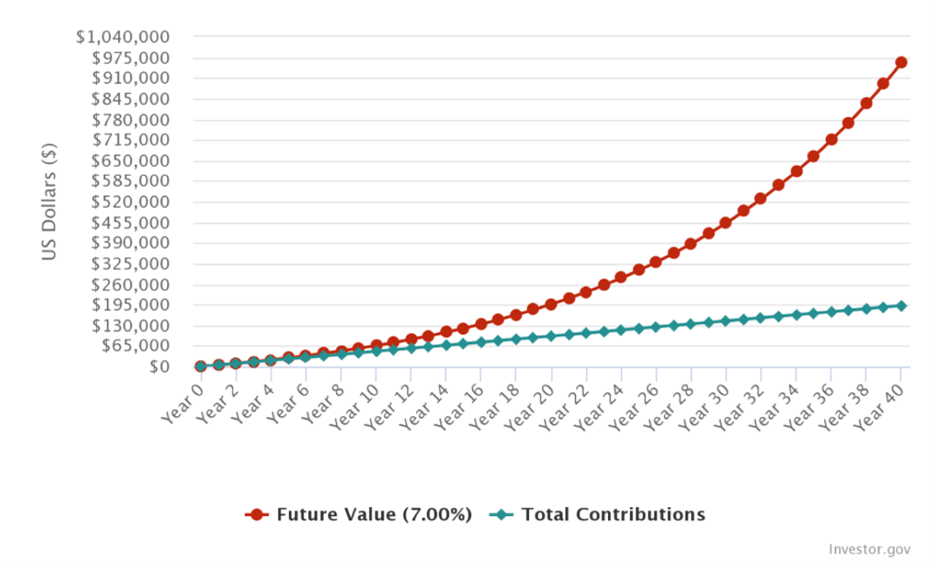Investing strategies for the Latino community

The Bankrate promise
At Bankrate we strive to help you make smarter financial decisions. While we adhere to strict , this post may contain references to products from our partners. Here's an explanation for .
Despite the rapid growth and influence of the Hispanic community in the United States, a 2021 survey from CNBC shows that about half (49 percent) of Hispanic Americans don’t own any investments, meaning they’re missing one of the most powerful opportunities to build wealth.
From 2010 to 2020, the Hispanic population in the U.S. increased by 23 percent, surpassing 62 million people, according to data by the United States Census Bureau. This ethnic group holds around $1.7 trillion in purchasing power. Whether in music, film, sports, business, or politics, Latino contributions to American society are undeniable.
Yet inadequate access to financial literacy has led most of this growing population to miss out on what has been the source of significant prosperity for other ethnic groups.
This guide outlines some investment strategies that could help set up Latinos – and their families – for ongoing financial success.
Latino investors and entrepreneurs by the numbers:
- About 61 percent of white U.S. households own some stock, compared to 28 percent of Hispanic households.
- 49 percent of Hispanics don’t currently own individual stocks, mutual funds, bonds, exchange-traded funds, cryptocurrency or real estate.
- In the decade from 2007 to 2017, Latinos started 50 percent of net new businesses in the U.S.
- Latino-owned businesses with less than $1 million in revenue are 19 percent less likely to receive full funding from a local bank than white-owned businesses.
- Latino-owned businesses that break through the $1 million level are three times less likely than white-owned businesses to seek financing from angel investors.
Source: Pew Research Center, Bain & Company, CNBC, Momentive
Saving vs. investing: How they differ
Saving and investing are the pillars of financial stability. Whether it’s buying a house, sending your kids to college, retiring comfortably, starting a business, or any other life goal, financial prosperity gives you options. But saving alone is not enough. That’s because the cost of living and the value of goods and services increase over time (inflation), eating away the buying power of your money.
Remember when your grandmother told you stories about how she would buy food for the family for only $20, but now it costs $100? That’s inflation. Most people turn to investments, especially those that could provide higher returns like the stock market, to stay ahead of inflation in the long run.
Think of saving as the fuel and investing as the engine that makes your money grow.
Making your money work for you
For most people, the allure of investing is receiving any form of earnings or interest on their principal. And when you reinvest those profits, you can capture one of the most powerful forces in investing: compound interest.
Compound interest incorporates earnings you add to your original investment, so you earn interest on interest. Over time, compound interest can result in exponential payoffs.
Consider a theoretical example where Amanda, a psychologist in California, starts investing at age 25, contributing $400 per month to an exchange-traded fund (ETF) that mimics the performance of the S&P 500 (a stock market index that tracks the largest 500 companies in the United States).
By age 65, Amanda would have contributed a total of $192,000. Assuming a 7 percent annual compound return for the S&P 500, her total investment would have grown to about $958,000.
Compound interest in action

The total earnings in this scenario aren’t far-fetched. For example, over the past 30 years, the S&P 500 posted an average annual gain of around 10 percent.
There’s one caveat, though. When it comes to compound interest, time is of the essence. In the scenario above, for example, should Amanda wait to start investing until she was 35, the return on her investment would be around $453,000, or about half the amount she could have received if she started at age 25.
Managing risk through diversification
Although all investments carry a certain level of risk, with the proper diversification, investors can mitigate significant losses while increasing the likelihood of generating returns. The objective is to ensure your asset allocation and risk tolerance aligns with your long-term financial goals.
Asset allocation is the mix of investments you own, such as stocks, bonds, funds, real estate, a personal business, and cash. And your risk tolerance is how much volatility you are willing to endure for a potential return.
For example, starting a family may mean you want to allocate more of your money toward a college savings account, such as a 529 plan. Planning to buy a house might mean having more cash on hand for a down payment. Getting a promotion might translate to maximizing your retirement accounts.
When building a portfolio of investments, start by considering what you want to achieve with that money, so that you can work backward from there.
Once you determine your optimal asset allocation, there is also a good chance those weightings will change as gains and losses accumulate. Consequently, staying engaged with your finances is essential, so you can recalibrate your portfolio as time passes and situations emerge. (Learn more about rebalancing your portfolio here.)
Best ways to start investing
Online trading has helped make investing more accessible to the masses. And to capitalize on this trend, many brokerage firms are increasingly offering low-cost services that used to be only available to wealthier individuals.
A brokerage firm acts as the intermediary between buyers and sellers, executing buy and sell orders at a stock exchange like the Nasdaq or the NYSE. For this service, brokerage firms would usually charge a fee. But as technology breaks down the barriers to entry and increases competition, most brokerage firms have been forced to adjust their business models to offer commission-free trading and other benefits.
Unlike a full-service broker, which gives clients access to perks like personalized investment advice, and estate and tax planning, among other services, discount brokers operate on a self-service model. That means retail investors are more in charge of their financial planning.
Online brokers have leveled the playing field for novice investors with benefits like no minimum deposits, zero-commission trading, free learning tools, and more.
Additionally, newer investment options like ETFs and robo-advisors help investors diversify their assets while decreasing investment costs. Plus, many online brokers offer free one-on-one consultations with professional financial advisors who can provide investment guidance. And many brokerage firms offer these services in Spanish, too.
The case for diversification through ETFs and mutual funds
Most ETFs and mutual funds provide a low-cost option for investors to diversify and access a wide range of investment themes.
There are two options for how fund managers select securities — passive and active investing. In a passively managed ETF, for example, a fund manager aims to replicate the performance of a broad index like the S&P 500. Alternatively, fund managers can buy or sell stocks, bonds and other securities at their discretion with actively managed funds.
Of course, both options usually come with a fee, but it’s often minimal compared to the work involved. The key is that investors remain diversified, potentially mitigating the volatility that comes with owning a narrow group of individual stocks. Plus, as economic factors change, such as a sudden spike in unemployment, active fund managers can tilt their holdings to take advantage of buy and sell opportunities.
When building your portfolio, aim to keep fees low. The more you can minimize unnecessary expenses, the more you can invest toward your financial future.
There are many ETFs and mutual fund categories available to retail investors. (Here are some of the top mutual funds for investors to consider.)
Supporting your community: Investing in Latino-owned businesses
Entrepreneurship runs in the Hispanic community’s DNA. And statistics show that Latino-owned businesses are growing exponentially, generating billions of dollars in revenue for the U.S. economy.
Nationwide, Latino-owned businesses increased 34 percent over the last decade, compared to 1 percent for all other small businesses, according to the State of Latino Entrepreneurship 2020 research study from Stanford University’s Latino Entrepreneurship Initiative.
Although these small businesses are a significant source of job creation, tax revenue, and innovation, access to capital remains a top challenge.
Stanford’s research reveals that only 20 percent of Latino-owned businesses seeking national bank loans over $100,000 received funding, compared to 50 percent for white-owned businesses. The lack of access to funding has led many entrepreneurs to turn to crowdfund sites like Honeycomb Credit in hopes of getting a loan in exchange for interest. Although you must exercise due diligence before financing these types of investments, the prospect of making someone’s dream come true can be rewarding.
There are also websites like Latin Businesses, a directory for Latino-owned businesses, to consider for investment opportunities.
By shopping at Latino-owned businesses, sharing their stories on social media, and even becoming an equity investor, you are participating in the success of the Latino community and America.
Prominent Latino investors and business leaders
Several noteworthy Latino investors and business leaders are redefining the role of success by prioritizing their communities. Here are some examples:
Orlando Bravo, founder and managing partner of Thoma Bravo
Billionaire investor Orlando Bravo manages a private equity firm specializing in software and technology companies. He has overseen over 380 acquisitions valued at more than $190 billion during his tenure.
To honor his heritage, he started the Bravo Family Foundation, which promotes entrepreneurship and leadership for young adults in Puerto Rico. In 2019, he committed more than $100 million to this cause.
Maria Contreras-Sweet, former administrator of the Small Business Administration (SBA) and founder of ProAmérica Bank
Besides serving as the head of SBA under President Obama, Maria Contreras-Sweet was the Secretary of Business, Transportation and Housing for the State of California, becoming the first Latina to hold a state cabinet post.
A long-time advocate for small businesses and an entrepreneur herself, she is the founding president of Hispanas Organized for Political Equality (HOPE). The non-profit organization fosters political and economic parity through leadership, advocacy and education. To date, HOPE has empowered more than 58,000 Latinas to become the leaders of tomorrow.
Adriana Cisneros, president and CEO of Grupo Cisneros
Venezuelan businesswoman Adriana Cisneros oversees the world’s largest private-owned media, entertainment, real estate, tourism and consumer goods company. The conglomerate reaches 550 million Spanish and Portuguese-speaking consumers in the Americas and Europe.
Cisneros is also the president of the Fundación Cisneros, a non-profit organization with a mission to improve education in Latin America and foster awareness of the region’s contribution to art and society. The foundation has helped thousands of students and teachers develop their skills through various initiatives.
Bottom line
In the words of singer, actress, and businesswoman, Gloria Estefan: “Whatever it is your heart desires, please go for it, it’s yours to have.” And for the Hispanic community, the sky’s the limit when it comes to achieving their financial dreams.
Editorial Disclaimer: All investors are advised to conduct their own independent research into investment strategies before making an investment decision. In addition, investors are advised that past investment product performance is no guarantee of future price appreciation.
Related Articles




Investing 101 for teachers: Learn the basics and how to get started